Impacts of Proanthocyanidin Binding on Conformational and Functional Properties of Decolorized Highland Barley Protein
Abstract
:1. Introduction
2. Materials and Methods
2.1. Materials
2.2. Preparation of DHBP
2.3. Preparation of DHBP–PC Complexes
2.4. Determination of PC Contents
2.5. Turbidity
2.6. Particle Size and Zeta Potential
2.7. Surface Hydrophobicity
2.8. Fluorescence Spectroscopy Analysis
2.8.1. Fluorescence Spectroscopy
2.8.2. Fluorescence Quenching
2.9. Structural Characteristics
2.9.1. Determination of the Contents of Free Sulfhydryl and Amino Groups
2.9.2. CD Spectroscopy
2.9.3. FTIR
2.10. Functional Properties Measurement
2.10.1. Foaming Property
2.10.2. Emulsifying Property
2.10.3. Antioxidant Activity
2.11. Statistical Analysis
3. Results and Discussion
3.1. Interactions of DHBP with PC
3.2. Turbidity and Particle Size
3.2.1. Turbidity
3.2.2. Particle Size
3.3. Surface Properties
3.3.1. Zeta Potential
3.3.2. Surface Hydrophobicity (H0)
3.4. Fluorescence Spectroscopy Analysis
3.5. Structural Analysis
3.5.1. Free Sulfhydryl and Amino Groups
3.5.2. FTIR
3.5.3. CD Analysis
3.6. Foaming Properties
3.7. Emulsifying Property
3.8. Antioxidant Activity
4. Conclusions
Supplementary Materials
Author Contributions
Funding
Data Availability Statement
Acknowledgments
Conflicts of Interest
References
- Deng, J.; Ma, X.; Zhao, T.; Yi, J.; Liu, X. Effect of highland barley-glucan on starch digestibility in vitro. Shipin Kexue Food Sci. 2018, 39, 106–111. [Google Scholar] [CrossRef]
- Guo, H.; Feng, K.L.; Zhou, J.; Liu, L.; Wei, S.Y.; Zhao, L.; Qin, W.; Gan, R.Y.; Wu, D.T. Carboxymethylation of Qingke β-glucans and their physicochemical properties and biological activities. Int. J. Biol. Macromol. 2020, 147, 200–208. [Google Scholar] [CrossRef] [PubMed]
- Obadi, M.; Sun, J.; Xu, B. Highland barley: Chemical composition, bioactive compounds, health effects, and applications. Food Res. Int. 2021, 140, 110065. [Google Scholar] [CrossRef] [PubMed]
- Ge, X.Z.; Jing, L.Z.; Zhao, K.; Su, C.Y.; Zhang, B.; Zhang, Q.; Han, L.H.; Yu, X.Z.; Li, W.H. The phenolic compounds profile, quantitative analysis and antioxidant activity of four naked barley grains with different color. Food Chem. 2021, 335, 127655. [Google Scholar] [CrossRef]
- Guo, T.L.; Horvath, C.; Chen, L.; Chen, J.; Zheng, B. Understanding the nutrient composition and nutritional functions of highland barley (Qingke): A review. Trends Food Sci. Technol. 2020, 103, 109–117. [Google Scholar] [CrossRef]
- Rauf, A.; Imran, M.; Abu-Izneid, T.; Patel, S.; Pan, X.D.; Naz, S.; Silva, A.S.; Saeed, F.; Suleria, H.A.R. Proanthocyanidins: A comprehensive review. Biomed. Pharmacother. 2019, 116, 108999. [Google Scholar] [CrossRef] [PubMed]
- Zhou, Z.K.; Sun, G.Y.; Lui, Y.Q.; Gao, Y.J.; Xu, J.J.; Meng, D.M.; Strappe, P.; Blanchard, C.; Yang, R. A novel approach to prepare protein-proanthocyanidins nano-complexes by the reversible assembly of ferritin cage. Food Sci. Technol. Res. 2017, 23, 329–337. [Google Scholar] [CrossRef] [Green Version]
- Dai, T.T.; Li, T.; Li, R.Y.; Zhou, H.L.; Liu, C.M.; Chen, J.; McClements, D.J. Utilization of plant-based protein-polyphenol complexes to form and stabilize emulsions: Pea proteins and grape seed proanthocyanidins. Food Chem. 2020, 329, 127219. [Google Scholar] [CrossRef]
- Jiang, J.; Zhang, Z.P.; Zhao, J.; Liu, Y.Y. The effect of non-covalent interaction of chlorogenic acid with whey protein and casein on physicochemical and radical-scavenging activity of in vitro protein digests. Food Chem. 2018, 268, 334–341. [Google Scholar] [CrossRef]
- Sui, X.; Sun, H.; Qi, B.; Zhang, M.; Li, Y.; Jiang, L. Functional and conformational changes to soy proteins accompanying anthocyanins: Focus on covalent and non-covalent interactions. Food Chem. 2018, 245, 871–878. [Google Scholar] [CrossRef]
- Hao, L.L.; Sun, J.W.; Pei, M.Q.; Zhang, G.F.; Li, C.; Li, C.M.; Ma, X.K.; He, S.X.; Liu, L.B. Impact of non-covalent bound polyphenols on conformational, functional properties and in vitro digestibility of pea protein. Food Chem. 2022, 383, 132623. [Google Scholar] [CrossRef] [PubMed]
- Li, T.; Wang, L.; Chen, Z.X.; Zhang, X.X.; Zhu, Z.Y. Functional properties and structural changes of rice proteins with anthocyanins complexation. Food Chem. 2020, 331, 127336. [Google Scholar] [CrossRef] [PubMed]
- Du, Y.; Chen, Z.X.; Liang, F.; Zhou, W.J.; Tu, Z.X.; Zhang, X.; Wang, Z.X.; Li, J. Effects of salidroside on functional and structural changes in highland barley proteins. LWT 2022, 160, 113310. [Google Scholar] [CrossRef]
- Du, Y.; Liang, F.; Chen, Z.X.; Zhou, W.J.; Tu, Z.X.; Li, J. Effects of decolorization on aggregation behavior of highland barley proteins: Comparison with wheat proteins. Food Res. Int. 2022, 160, 111712. [Google Scholar] [CrossRef] [PubMed]
- Yang, X.J.; Dang, B.; Fan, M.T. Free and bound phenolic compound content and antioxidant activity of different cultivated blue highland barley varieties from the Qinghai-Tibet Plateau. Molecules 2018, 23, 879. [Google Scholar] [CrossRef] [PubMed] [Green Version]
- Kato, A.; Nakai, S. Hydrophobicity determined by a fluorescence probe method and its correlation with surface properties of proteins. Biochim. Biophys. Acta (BBA)-Protein Struct. 1980, 624, 13–20. [Google Scholar] [CrossRef]
- Mohammadi, F.; Moeeni, M. Analysis of binding interaction of genistein and kaempferol with bovine α-lactalbumin. J. Funct. Foods 2015, 12, 458–467. [Google Scholar] [CrossRef]
- Lakowicz, J.R.; Freshwater, G.; Weber, G. Nanosecond segmental mobilities of tryptophan residues in proteins observed by lifetime-resolved fluorescence anisotropies. Biophys. J. 1980, 32, 591–601. [Google Scholar] [CrossRef] [Green Version]
- Wang, Z.H.; Zhang, G.; Zhou, Q.; Fei, Z.; Liu, Z.; Li, Z. Fluorescence spectroscopic investigation of the interaction between benzidine and bovine hemoglobin. J. Mol. Struct. 2008, 886, 77–84. [Google Scholar] [CrossRef]
- Perozzo, R.; Folkers, G.; Scapozza, L. Thermodynamics of protein-ligand interactions: History, presence, and future aspects. J. Recept. Signal Transduct. Res. 2004, 24, 1–52. [Google Scholar] [CrossRef]
- Beveridge, T.; Toma, S.J.; Nakai, S. Determination of SH- and SS-groups in some food proteins using Ellman’s reagent. J. Food Sci. 1974, 39, 49–51. [Google Scholar] [CrossRef]
- Vigo, M.S.; Malec, L.S.; Gomez, R.G.; Llosa, R.A. Spectrophotometric assay using o-phthaldialdehyde for determination of reactive lysine in dairy products. Food Chem. 1992, 44, 363–365. [Google Scholar] [CrossRef]
- Benzie, I.F.F.; Strain, J.J. The ferric reducing ability of plasma (FRAP) as a measure of “antioxidant power”: The FRAP assay. Anal. Biochem. 1996, 239, 70–76. [Google Scholar] [CrossRef] [PubMed] [Green Version]
- Chen, K.W.; Chen, X.; Liang, L.; Xu, X. Gallic acid-aided cross-linking of myofibrillar protein fabricated soluble aggregate for enhanced thermal stability and tunable colloidal state. J. Agric. Food Chem. 2020, 68, 11535–11544. [Google Scholar] [CrossRef]
- Nagy, K.; Courtet-Compondu, M.C.; Williamson, G.; Rezzi, S.; Kussmann, M.; Rytz, A. Non-covalent binding of proteins to polyphenols correlates with their amino acid sequence. Food Chem. 2012, 132, 1333–1339. [Google Scholar] [CrossRef]
- Pan, X.; Fang, Y.; Wang, L.L.; Shi, Y.; Xie, M.H.; Xia, J.; Pei, F.; Li, P.; Xiong, W.; Shen, X.; et al. Covalent interaction between rice protein hydrolysates and chlorogenic acid: Improving the stability of oil-in-water emulsions. J. Agric. Food Chem. 2019, 67, 4023–4030. [Google Scholar] [CrossRef] [PubMed]
- Ren, C.; Xiong, F.W.; Peng, D.F.; He, Y.; Zhou, P.Y.; Li, J.; Li, B. Effects of thermal sterilization on soy protein isolate/polyphenol complexes: Aspects of structure, in vitro digestibility and antioxidant activity. Food Res. Int. 2018, 112, 284–290. [Google Scholar] [CrossRef] [PubMed]
- Ma, X.; Yan, T.; Hou, F.; Chen, W.; Miao, S.; Liu, D. Formation of soy protein isolate (SPI)-citrus pectin (CP) electrostatic complexes under a high-intensity ultrasonic field: Linking the enhanced emulsifying properties to physicochemical and structural properties. Ultrason. Sonochem. 2019, 59, 104748. [Google Scholar] [CrossRef]
- Li, D.; Zhao, Y.; Wang, X.; Tang, H.L.; Wu, N.; Wu, F.; Yu, D.Y.; Elfalleh, W. Effects of (+)-catechin on a rice bran protein oil-in-water emulsion: Droplet size, zeta-potential, emulsifying properties, and rheological behavior. Food Hydrocoll. 2020, 98, 105306. [Google Scholar] [CrossRef]
- Jiang, Z.M.; Li, T.Q.; Ma, L.; Chen, W.; Yu, H.Y.; Abdul, Q.; Hou, J.C.; Tian, B. Comparison of interaction between three similar chalconoids and α-lactalbumin: Impact on structure and functionality of α-lactalbumin. Food Res. Int. 2020, 131, 109006. [Google Scholar] [CrossRef]
- Tong, X.H.; Cao, J.; Tian, T.; Lyu, B.; Miao, L.M.; Lian, Z.T.; Cui, W.Y.; Liu, S.; Wang, H.; Jiang, L.Z. Changes in structure, rheological properties and antioxidant activity of soy protein isolate fibrils by ultrasound pretreatment and EGCG. Food Hydrocoll. 2021, 112, 107084. [Google Scholar] [CrossRef]
- Cheng, J.R.; Zhu, M.J.; Liu, X.M. Insight into the conformational and functional properties of myofibrillar protein modified by mulberry polyphenols. Food Chem. 2020, 308, 125592. [Google Scholar] [CrossRef] [PubMed]
- Huang, L.; Ding, X.; Dai, C.; Ma, H. Changes in the structure and dissociation of soybean protein isolate induced by ultrasound-assisted acid pretreatment. Food Chem. 2017, 232, 727–732. [Google Scholar] [CrossRef] [PubMed]
- Tapal, A.; Tiku, P.K. Complexation of curcumin with soy protein isolate and its implications on solubility and stability of curcumin. Food Chem. 2012, 130, 960–965. [Google Scholar] [CrossRef]
- Liu, F.G.; Sun, C.X.; Yang, W.; Yuan, F.; Gao, Y.X. Structural characterization and functional evaluation of lactoferrin-polyphenol conjugates formed by free-radical graft copolymerization. RSC Adv. 2015, 5, 15641–15651. [Google Scholar] [CrossRef]
- Li, C.H.; Dai, T.T.; Chen, J.; Li, X.; Li, T.; Liu, C.M.; Mcclements, D.J. Protein-polyphenol functional ingredients: The foaming properties of lactoferrin are enhanced by forming complexes with procyanidin. Food Chem. 2021, 339, 128145. [Google Scholar] [CrossRef] [PubMed]
- Xiang, C.Y.; Gao, J.; Ye, H.X.; Ren, G.R.; Ma, X.J.; Xie, H.J.; Fang, S.; Lei, Q.; Fang, W. Development of ovalbumin-pectin nanocomplexes for vitamin D3 encapsulation: Enhanced storage stability and sustained release in simulated gastrointestinal digestion. Food Hydrocoll. 2020, 106, 105926. [Google Scholar] [CrossRef]
- Zhao, Y.; Wang, X.; Li, D.; Tang, H.L.; Yu, D.Y.; Wang, L.Q.; Jiang, L.Z. Effect of anionic polysaccharides on conformational changes and antioxidant properties of protein-polyphenol binary covalently-linked complexes. Process. Biochem. 2019, 89, 89–97. [Google Scholar] [CrossRef]
- Xu, Y.J.; Han, M.Y.; Huang, M.Y.; Xu, X.L. Enhanced heat stability and antioxidant activity of myofibrillar protein-dextran conjugate by the covalent adduction of polyphenols. Food Chem. 2021, 352, 129376. [Google Scholar] [CrossRef]
- Dai, T.T.; Chen, J.; McClement, D.J.; Hu, P.; Ye, X.Q.; Liu, C.M.; Li, T. Protein–polyphenol interactions enhance the antioxidant capacity of phenolics: Analysis of rice glutelin–procyanidin dimer interactions. Food Funct. 2019, 10, 765. [Google Scholar] [CrossRef]
- Li, F.F.; Wang, B.; Liu, Q.; Chen, Q.; Zhang, H.E.; Xia, X.F.; Kong, B.H. Changes in myofibrillar protein gel quality of porcine longissimus muscle induced by its structural modification under different thawing methods. Meat Sci. 2019, 147, 108–115. [Google Scholar] [CrossRef] [PubMed]
- Fan, Y.T.; Li, G.H.; Yi, J.; Huang, H.M. Structural characteristics, emulsifying and foaming properties of laccase-crosslinked bovine α-lactalbumin mediated by caffeic acid. Food Hydrocoll. 2022, 133, 107948. [Google Scholar] [CrossRef]

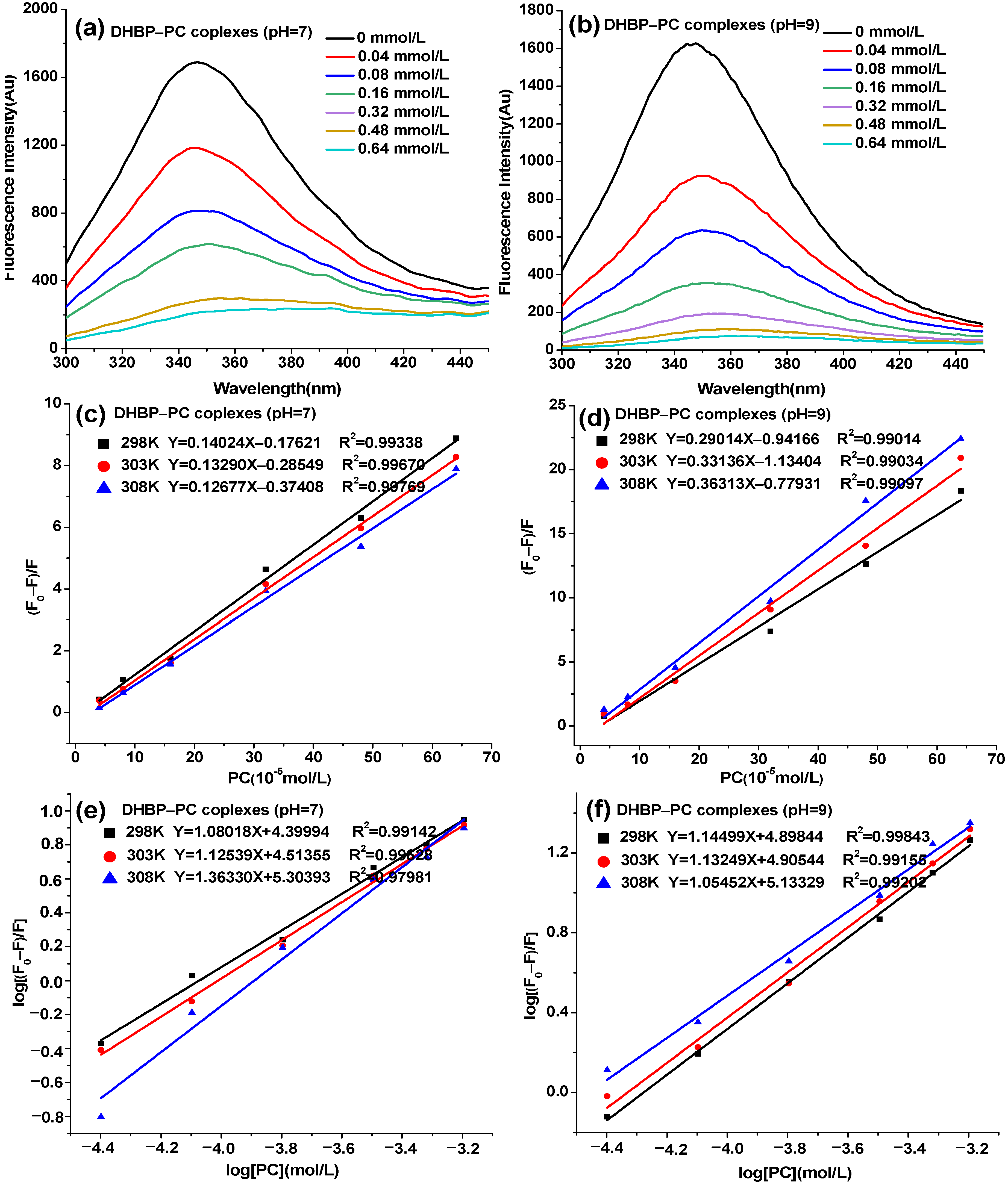
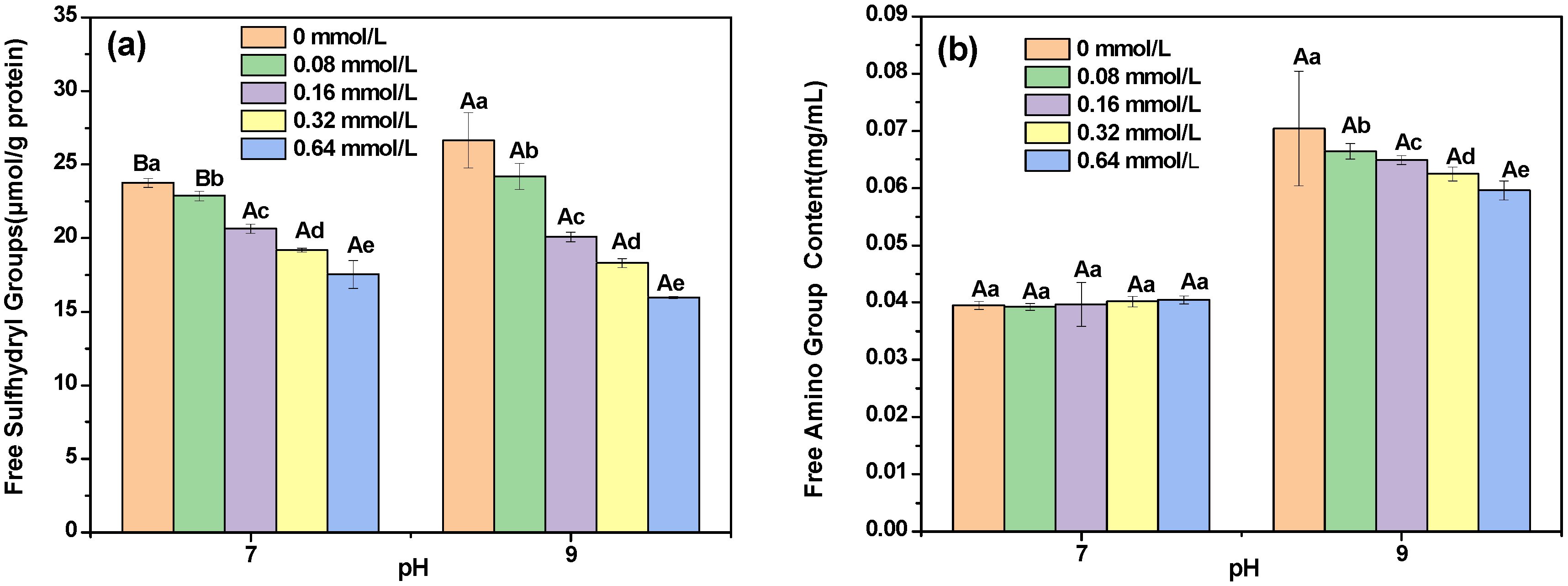
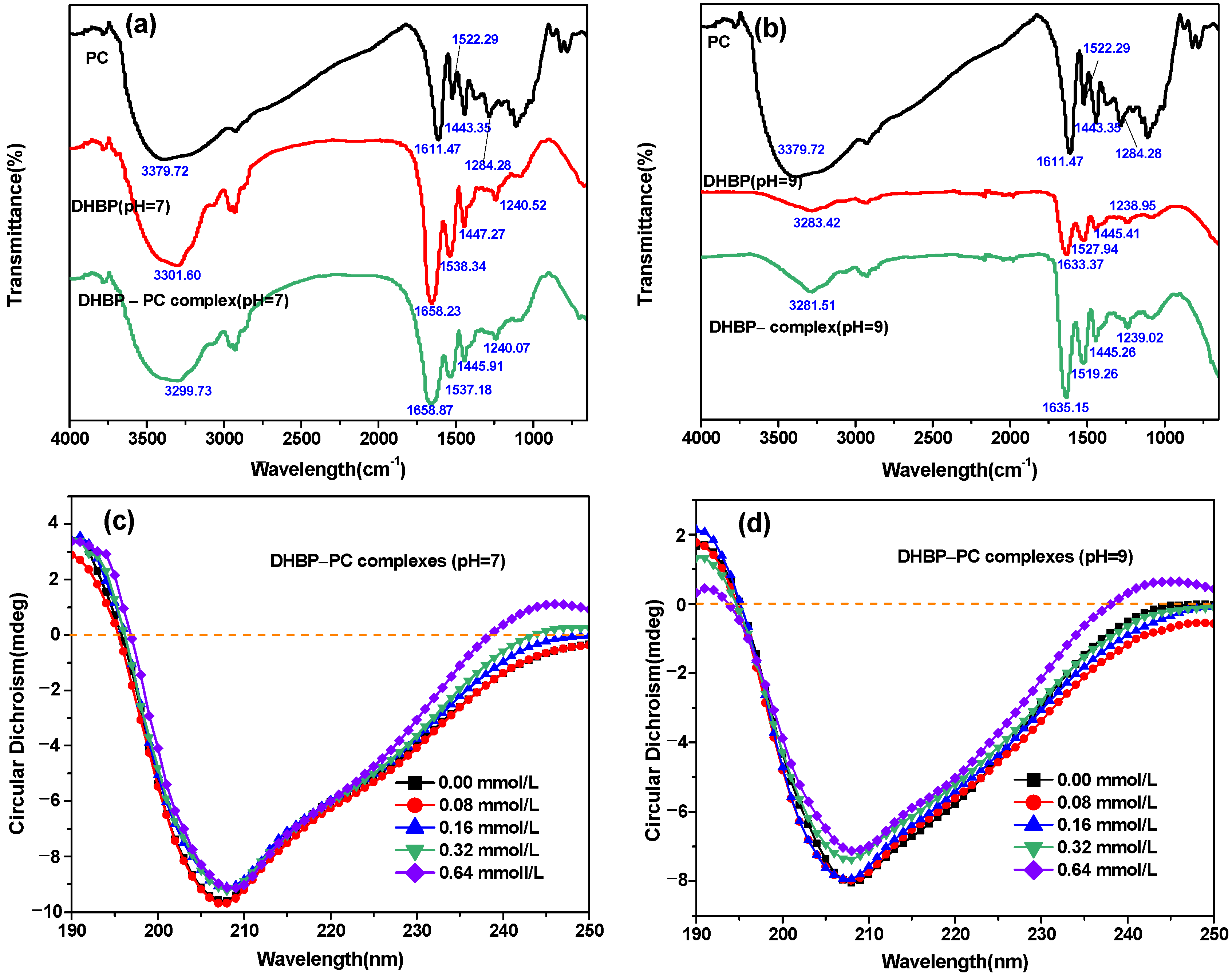
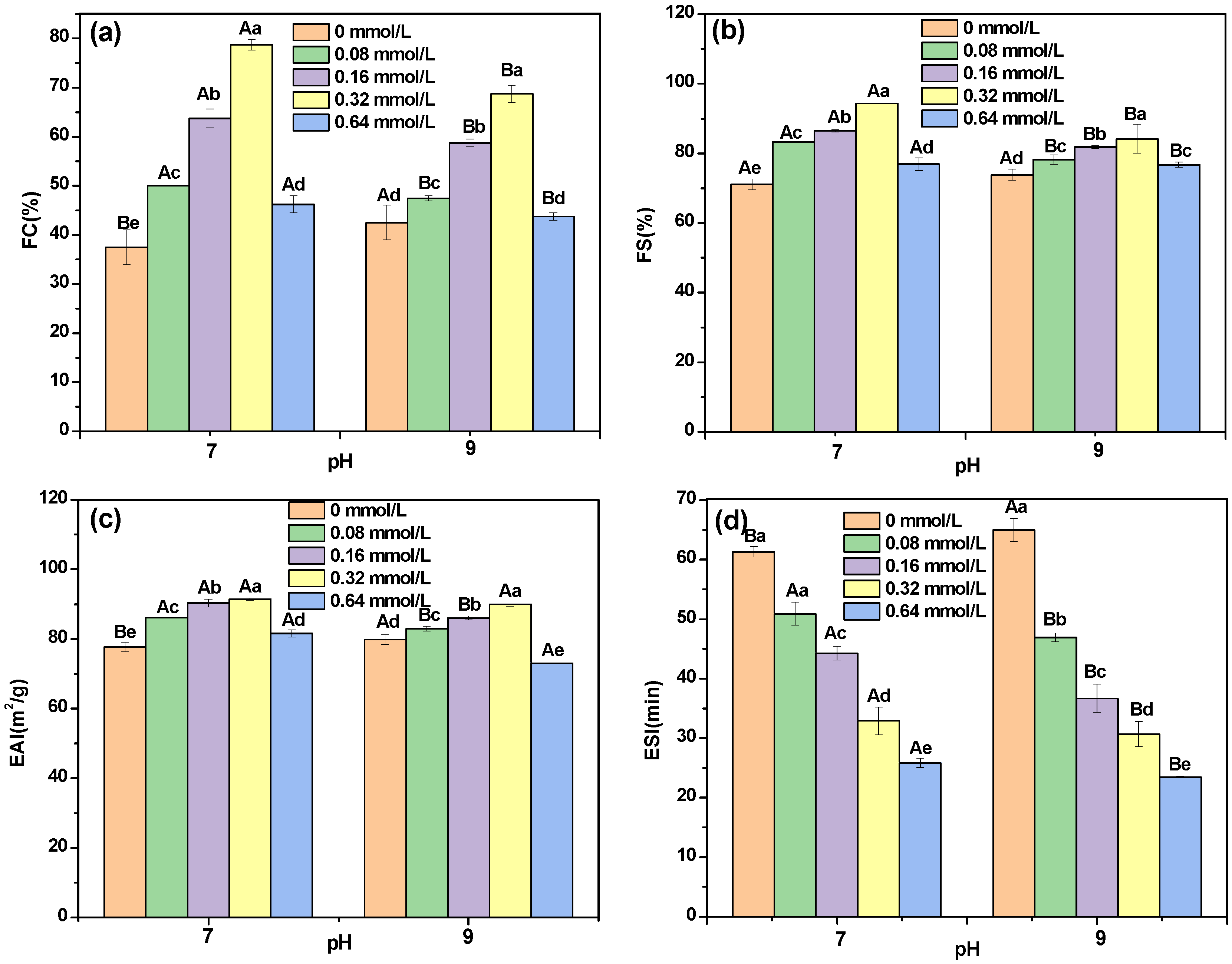
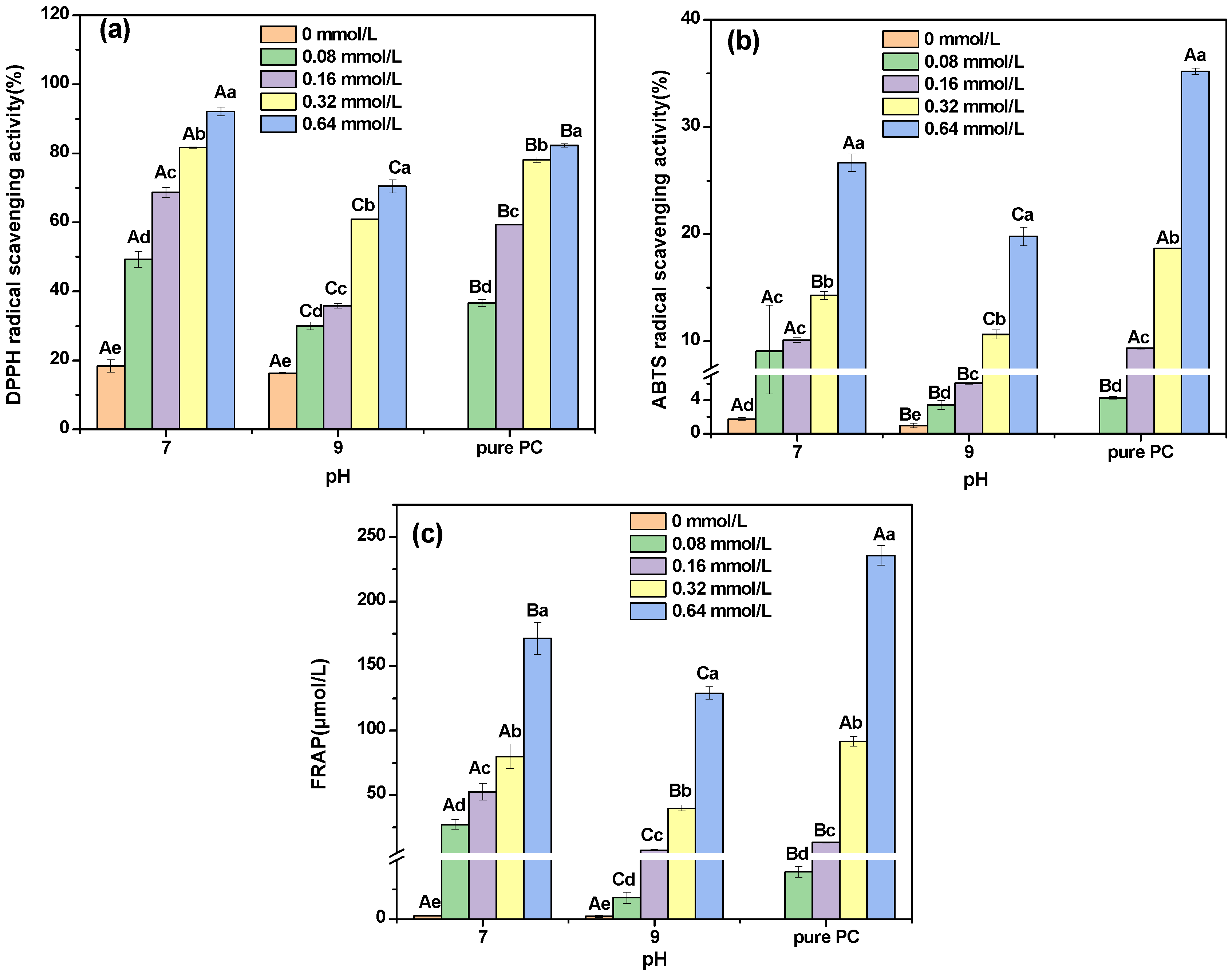
| PC Concentration (mmol/L Protein) | DHBP–PC Complexes (pH = 7) | DHBP–PC Complexes (pH = 9) |
|---|---|---|
| 0.08 | 12.05 ± 0.21 Ad | 10.00 ± 0.42 Bd |
| 0.16 | 25.87 ± 1.04 Ac | 22.05 ± 1.25 Bc |
| 0.32 | 59.18 ± 0.83 Ab | 54.36 ± 3.12 Bb |
| 0.64 | 135.04 ± 1.66 Aa | 117.57 ± 3.12 Ba |
| DHBP–PC Complexes (pH = 7) | DHBP–PC Complexes (pH = 9) | |||||
|---|---|---|---|---|---|---|
| 298 K | 303 K | 308 K | 298 K | 303 K | 308 K | |
| Ksv (L/mol) | 1.4024 × 104 | 1.3290 × 104 | 1.2677 × 104 | 2.9014 × 104 | 3.3136 × 104 | 3.6313 × 104 |
| Kq (L/mol/s) | 1.4024 × 1012 | 1.3290 × 1012 | 1.2677 × 1012 | 2.9014 × 1012 | 3.3136 × 1012 | 3.6313 × 1012 |
| Ka (L/mol) | 2.51 × 104 | 3.26 × 104 | 2.01 × 105 | 7.91 × 104 | 8.04 × 104 | 1.36 × 106 |
| n | 1.08018 | 1.12539 | 1.13633 | 1.14499 | 1.13249 | 1.05452 |
| ΔG (kJ/mol) | –27.52 | –28.89 | ||||
| ΔH (kJ/mol) | 159.51 | 41.48 | ||||
| ΔS (kJ/mol/K) | 0.62 | 0.23 | ||||
Disclaimer/Publisher’s Note: The statements, opinions and data contained in all publications are solely those of the individual author(s) and contributor(s) and not of MDPI and/or the editor(s). MDPI and/or the editor(s) disclaim responsibility for any injury to people or property resulting from any ideas, methods, instructions or products referred to in the content. |
© 2023 by the authors. Licensee MDPI, Basel, Switzerland. This article is an open access article distributed under the terms and conditions of the Creative Commons Attribution (CC BY) license (https://creativecommons.org/licenses/by/4.0/).
Share and Cite
Li, J.; Zhang, X.; Zhou, W.; Tu, Z.; Yang, X.; Hao, J.; Liang, F.; Chen, Z.; Du, Y. Impacts of Proanthocyanidin Binding on Conformational and Functional Properties of Decolorized Highland Barley Protein. Foods 2023, 12, 481. https://doi.org/10.3390/foods12030481
Li J, Zhang X, Zhou W, Tu Z, Yang X, Hao J, Liang F, Chen Z, Du Y. Impacts of Proanthocyanidin Binding on Conformational and Functional Properties of Decolorized Highland Barley Protein. Foods. 2023; 12(3):481. https://doi.org/10.3390/foods12030481
Chicago/Turabian StyleLi, Juan, Xin Zhang, Wenju Zhou, Zhaoxin Tu, Xijuan Yang, Jing Hao, Feng Liang, Zhengxing Chen, and Yan Du. 2023. "Impacts of Proanthocyanidin Binding on Conformational and Functional Properties of Decolorized Highland Barley Protein" Foods 12, no. 3: 481. https://doi.org/10.3390/foods12030481





